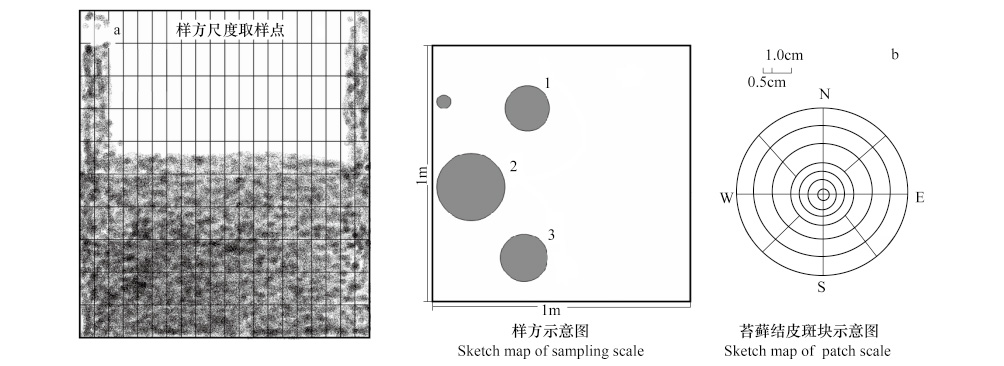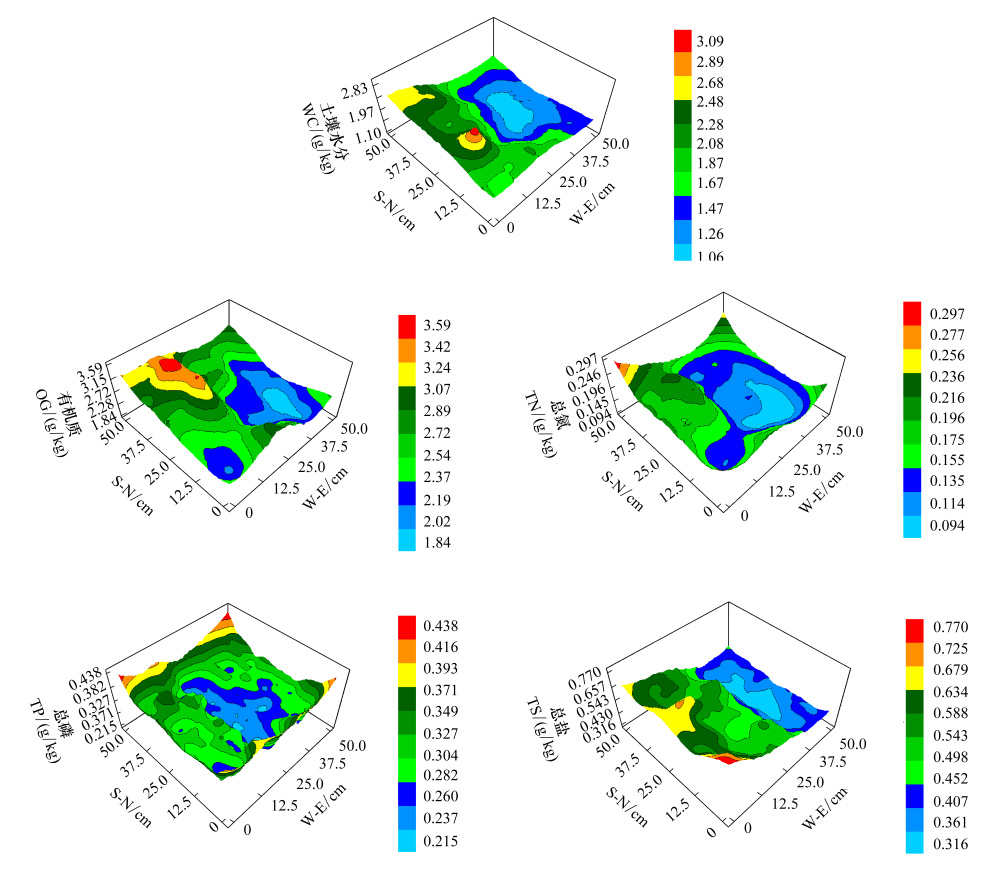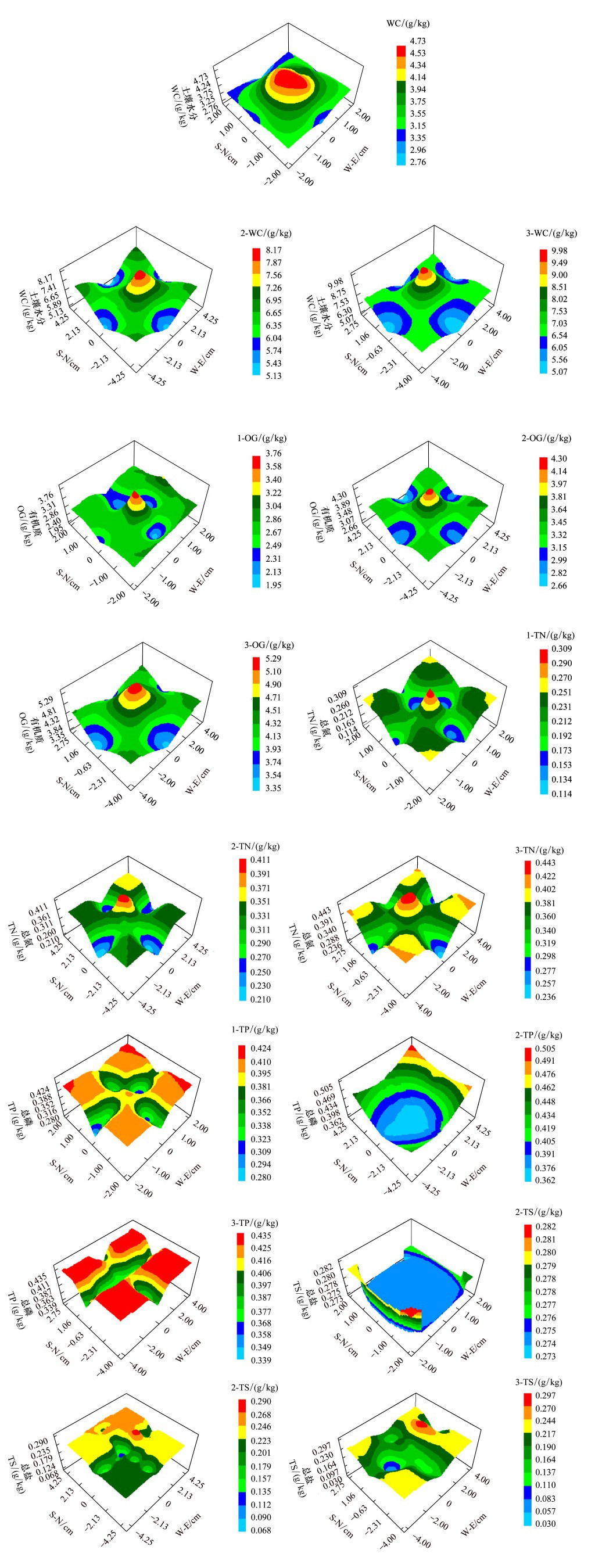文章信息
- 吉雪花, 张元明, 周小兵, 吴林, 张静
- JI Xuehua, ZHANG Yuanming, ZHOU Xiaobing, WU Lin, ZHANG Jing
- 不同尺度苔藓结皮土壤性状的空间分布特征
- Spatial distribution of soil properties covered by moss crusts on different scales
- 生态学报, 2014, 34(14): 4006-4016
- Acta Ecologica Sinica, 2014, 34(14): 4006-4016
- http://dx.doi.org/10.5846/stxb201212041747
-
文章历史
- 收稿日期:2012-12-4
- 修订日期:2014-2-27
2. 中国科学院新疆生态与地理研究所, 乌鲁木齐 830001
2. Xinjiang Institute of Ecology and Geography, Chinese Academy of Science, Urumqi 830001, China
空间异质性是植被格局形成的主要原因[1, 2],是一个依赖于尺度的生态学概念[3],异质性的程度随着尺度的变化而改变[4],同一变量,从某一尺度看可能是异质的,但缩小研究尺度到某一范围后,可能表现为均质[5, 6]。一般情况下,随着取样点距离加大,随机因素在变异中的比重将会增加,小尺度下的异质性将被掩盖[7, 8],而多尺度的研究却可以弥补此缺陷,因此多尺度分析已经成为研究空间异质性的首要内容和手段。
土壤空间异质性是自然界中最常见一种空间异质性[9, 10],这种现象在有灌木的沙漠和草原生态系统中尤为典型[11]。与尺度相关的土壤空间异质性在灌木中得到了较高的重视,从根系[12]到个体[13, 14],从地貌[15, 16]到区域[17, 18]开展了全面而系统的研究。李从娟等[19]从根际、个体、种群、地貌和区域5个尺度对古尔班通古特沙漠土壤化学属性的空间异质性进行了研究,结果表明同一属性在不同研究尺度下表现出不同的空间变异程度,土壤pH值在各尺度异质性的顺序为:个体> 种群> 地貌> 区域> 根际,而土壤有机质、全氮则表现为个体尺度上最大,地貌尺度上次之,种群尺度上最小。吴乐知和蔡祖聪[20]在不同尺度对我国土壤有机质含量进行分析,结果表明随着取样空间尺度增大,土壤有机质的变异系数逐渐下降,即从县级的50%下降到省级的40%和大区级的31%。沈海亮等[21]对宁夏野生甘草的分布进行研究,发现在较小的研究尺度上随机因素对其分布格局起着重要作用,而在较大尺度上结构性因素则起到了控制作用。上述研究对空间异质性及尺度效应的探索和发展做出了很大的贡献,深化了对尺度与植被格局关系的认识。研究不同尺度土壤的空间异质性,有助于深入了解土壤性状在某一尺度空间异质性的强度和范围,明确不同生态学现象所对应的尺度以及某一生态现象的临界尺度,从而为实际操作中土样的采集提供理论依据。
大量研究证实苔藓结皮的存在能够改变土壤理化性质,增加表层土壤养分含量[22, 23]。苔藓植物对水分高度敏感,在干旱半干旱区苔藓植物通常分布在阴湿、低洼地。在古尔班通古特沙漠苔藓结皮通常以大小不一的斑块分布在丘间低地,苔藓结皮的这种斑块状分布必然造成土壤性状的不均匀分布,导致空间异质性。 目前有关结皮土壤性状空间异质性的研究多集中在结皮覆盖区与无结皮覆盖区养分含量的比较上,对结皮内部土壤性状空间异质性发生的强度、范围及其与尺度的关系尚缺乏研究。本研究以苔藓结皮斑块为例,在两种尺度上分析了苔藓结皮土壤性状的空间分布特征,旨在阐明苔藓结皮斑块土壤性状在空间上的变异强度和发生范围,为实际操作中苔藓结皮土壤取样提供理论依据和数据支持。
1 材料与方法 1.1 研究区概况古尔班通古特沙漠 (44°15′— 46°50′ N,84°50′— 91°20′ E)是中国面积最大的固定、半固定沙漠,为典型的大陆性干旱气候,年平均温度-5.7 ℃,极端最高气温40 ℃以上,极端最低气温低于 -40 ℃,年降水量80 —160 mm,年蒸发量2000 mm,干燥度16级以上,空气相对湿度平均50%—60%,5—8月份通常在45%以下。土壤肥力极为瘠薄,沙丘表面植被覆盖度仅有15% —50%,主要植物种有白梭梭(Haloxylon persicum)、梭梭(Haloxylon ammodendron)、 蛇麻黄(Ephedra distachya)、沙拐枣(Calligonum leucocladum)、沙篙(Artemisia arenaria)等耐旱植物。由于降水的季节分配较均匀,使短命和类短命植物获得一定发育。除此之外,沙漠地表还发育有良好的生物结皮,苔藓结皮主要发生在丘间低地,齿肋赤藓(Syntrichia caninervis)是其中的优势种[24],本研究中齿肋赤藓的纯度在90%以上,其它苔藓种类见表 1[25]。 研究区土壤为碱性沙壤土,pH值8.6,容重1.36 g/cm3(含1.6%—1.7% 壤土,13% —14% 细土和 85% 沙土,沙土中细沙、中沙和极细沙分别占约23%—29%,粗沙含量约为5%。
| 平均厚度/cm Average thickness | 常见种 Common species |
| 2.2 | 齿肋赤藓Syntrichia caninervis, 银叶真藓Bryum argenteum, 绿色流苏藓Crassidium chloronotos, 泛生墙藓Tortula muralis |
本研究以表层土样 (0—10 cm)为研究对象,土样采集于2010年5月。为减少由于特殊立地条件引起的误差,样方尺度和斑块尺度均设3个重复进行土壤采样,文中数据均为3个重复的平均值。样方设在平坦低地,大小为50 cm × 50 cm,样方内50%覆盖藓类结皮,其它为裸地,东西以2.5 cm为间隔,南北以5 cm为间隔划分样方,如图 1a所示,两线交错点为采样点,共171个样点;用铁铲切取土样,每点土样重约80 g。斑块尺度土样采集在100 cm × 100 cm的样地内随机选取3个直径4 cm以上的藓类结皮斑块,土样的采集以斑块中心为起点分别以半径 0.5 cm,1 cm,1.5 cm,2 cm,3 cm,4 cm,5 cm和6 cm在东西南北四个方向取样,取样深度0—10 cm,不规则斑块按照其在各方向上的长度取样(图 1b),本文中斑块1、2、3 分别有16、34、32个取样点,其它数据由克里格插值(Kriging)法获得。

|
| 图 1 土壤采样 Fig. 1 Soil sampling (a)图中黑色部分为结皮覆盖区,空白部分为裸地;(b)图中黑色圆代表苔藓结皮斑块,空白区域代表裸地 |
将采集好的土样在自然状态下风干后,过 2 mm筛。土壤 pH值以土水比 1 ∶ 5的悬浊液采用酸度计(pHS22C) 测定;土壤有机质采用重铬酸钾容量法—外加热法(LWY84B型控温式铝体消煮炉);全氮采用凯氏法,高氯酸-硫酸消化法(LWY84B型控温式铝体消煮炉);全磷采用酸溶-钼锑抗比色法(LWY84B型控温式铝体消煮炉)[26];水溶性总盐采用残渣烘干-重量法;土壤水分含量-烘干称重法。
1.3 数据处理本文采用SPSS 17.0 (IBM SPSS Statistics 17.0)处理数据。采用Excel 2003 制表,GS+ 5.0绘图。
2 结果分析 2.1 苔藓结皮土壤性状空间异质性的统计特征由统计分析可知,样方尺度5个土壤性状基本符合正态分布,满足地统计学分析的要求。标准差反映了绝对变异的大小,而变异系数(Coefficient Variation,CV)则反映了相对变异的程度,其数值大小等于标准差(SD)与平均值(mean)的比值。由表 2可知,在样方尺度,样方内土壤含水量(WC),有机质 (OG),全氮 (TN),全磷 (TP),总盐 (TS)的变异系数分别为26.66%,22.55%,30.16%,12.65%和26.12%,其值都在10%—100%之间,按照赵锐锋等[27]的标准属于中等程度的变异。
| 土壤属性 Soil properties | 平均值 Mean /(g/kg) | 标准差 Standard Deviation(SD) | 标准误 Standard Error(SE) | 变异系数 Coefficient Variation (CV)/% | 最小值 Minimum /(g/kg) | 最大值 Maximum /(g/kg) |
| 水分WC | 1.670 | 0.445 | 0.198 | 26.66 | 0.59 | 2.96 |
| 有机质OG | 2.543 | 0.573 | 0.329 | 22.55 | 1.37 | 4.73 |
| 全氮TN | 0.149 | 0.05 | 0.002 | 30.16 | 0.08 | 0.310 |
| 全磷TP | 0.290 | 0.037 | 0.001 | 12.65 | 0.20 | 0.38 |
| 总盐TS | 0.492 | 0.129 | 0.016 | 26.12 | 0.25 | 0.85 |
斑块尺度,3个大小不同的苔藓结皮斑块土壤性状的变异系数范围分别为WC(17.73%—23.06%)、OG(14.55%—20.15%)、TN(20.67%—26.732%)、TS(17.73%—20.32%)、TP(5.14%—8.82%)(表 3),由此可知除TP外,各斑块其它4个土壤性状的变异系数都在10%—100%之间,说明斑块尺度上述4个土壤性状表现出中等程度的变异,这与样方尺度的分析结果一致;而TP(5.14%—8.82%)的变异系数小于10%,比样方尺度的变异强度降低了4%—7%,其它4个土壤性状在斑块尺度的变异小于或接近样方尺度的的变异。两种尺度下苔藓结皮土壤各因子中,TN的空间异质性最大,而TP 空间异质性最小。
| 土壤属性 Soil properties | 平均值 Mean /(g/kg) | 标准差 Standard Deviation(SD) | 标准误 Standard Error(SE) | 变异系数 Coefficient Variation (CV)/% | 最小值 Minimum /(g/kg) | 最大值 Maximum /(g/kg) |
| 1-WCI水分 | 3.871 | 0.752 | 0.596 | 19.42 | 2.61 | 4.92 |
| 2-WC水分 | 6.400 | 1.135 | 0.236 | 17.73 | 4.68 | 8.82 |
| 3-WC水分 | 6.812 | 1.571 | 0.406 | 23.06 | 5.02 | 10.14 |
| 1-OG有机质 | 2.583 | 0.526 | 0.144 | 20.15 | 1.93 | 3.76 |
| 2-OG有机质 | 3.214 | 0.648 | 0.133 | 19.94 | 2.33 | 5.00 |
| 3-OG有机质 | 4.265 | 0.629 | 0.159 | 14.55 | 3.32 | 5.31 |
| 1-TN全氮 | 0.187 | 0.050 | 0.015 | 26.73 | 0.11 | 0.31 |
| 2-TN全氮 | 0.267 | 0.060 | 0.020 | 22.47 | 0.15 | 0.48 |
| 3-TN全氮 | 0.333 | 0.068 | 0.017 | 20.67 | 0.23 | 0.44 |
| 1-TP全磷 | 0.345 | 0.036 | 0.091 | 8.82 | 0.28 | 0.39 |
| 2-TP全磷 | 0.397 | 0.033 | 0.011 | 7.69 | 0.33 | 0.61 |
| 3-TP全磷 | 0.371 | 0.019 | 0.005 | 5.14 | 0.33 | 0.41 |
| 1-TS总盐 | 0.224 | 0.039 | 0.001 | 17.73 | 0.20 | 0.30 |
| 2-TS总盐 | 0.187 | 0.038 | 0.011 | 20.32 | 0.10 | 0.30 |
| 3-TS总盐 | 0.169 | 0.031 | 0.013 | 18.99 | 0.10 | 0.30 |
用GS+软件进行半方差模型的拟合,结果见表 4,表 5。由表 4可知,样方尺度,苔藓结皮土壤WC、OG、TN、TS均符合球面模型,决定系数r2值都在0.95以上,残差RSS均在10-4以下,这说明此模型能较好的反映以上4个土壤性状的空间结构特征,TP是指数模型,决定系数r2为0.772,与其它因子相比,模型的精度稍差(表 4);斑块尺度3个斑块5个土壤性状主要适用于指数和球面模型(1号斑块TS除外),除最小的1号斑块模型精度较低外,其它2个斑块模型的决定系数都在0.6以上。1号斑块的TS出现了线性模型,说明TS在小斑块内不存在空间异质性,其异质性应该存在于更大的尺度范围内(表 5)。块金值(Co)表示随机部分的空间异质性,拱高(C)表示系统变异的空间异质性,拱高与基台值(Co+C)之比反映自相关部分的空间异质性占总空间异质性的程度。本研究中,半方差分析结果表明,不同尺度下苔藓结皮土壤各性状的Co(<0.01)都较小,表明苔藓结皮土壤各性状存在较强的空间结构性。本研究中样方尺度,土壤OG (67.35%),TN(65.29),WC(80.62%),TP(92.88%),TS (88.88%) 的C/Co+C值均在65%以上,说明在样方尺度,苔藓结皮上述土壤性状具有较强的空间依赖性,在变程内各因子具有较强的自相关性,结构性因素对苔藓结皮土壤WC、TP、TS的变异起着主导作用,而OG和TN的空间变异则是由结构变异和随机变异共同作用形成。斑块尺度,除TP外,其它各因子由自相关引起的空间变异比重增加,由结构因素引起的变异比重较样方水平也升高了,随机变异在斑块尺度几乎不起作用;土壤TP中由自相关引起的变异在斑块尺度下降,结构性因素在总变异中的比重也降低了。采样尺度不同,土壤各因子的变程(Ao)也有显著变化,由表 4可知,样方尺度WC、OG、TN的变程大于结皮覆盖范围,TP的变程小于结皮覆盖范围,而TS的变程则大于样方。除此之外,变程也随结皮斑块大小的改变而变化,由表 5可知,1号斑块除TS外,其余土壤性状的变程均小于斑块直径;2号斑块除TN、TS外,其他土壤性状的变程均与斑块大小一致;而3号斑块土壤各性状的变程均小于斑块。总体上,各取样尺度下苔藓结皮土壤的TP变程均最小,TS变程最大。
| 土壤属性 Soil properties | 理论模型 Model | 块金值 Nugget Co | 基台值 Sill Co+C | 变程 Range Ao | 自相关比例 C(Co+C) /% | 决定系数 r2 | 残差 RSS |
| 水分含量WC | Spherical | 0.016 | 0.081 | 48.76 | 80.62 | 0.986 | 7.38×10-6 |
| 有机质OG | Spherical | 0.010 | 0.031 | 42.73 | 67.35 | 0.985 | 2.68×10-6 |
| 全氮TN | Spherical | 6.36×10-4 | 1.83×10-3 | 39.82 | 65.29 | 0.989 | 6.36×10-9 |
| 全磷TP | Exponential | 6.20×10-5 | 8.71×10-4 | 5.52 | 92.88 | 0.772 | 1.95×10-8 |
| 总盐TS | Spherical | 1.68×10-3 | 1.52×10-2 | 81.21 | 88.88 | 0.958 | 1.47×10-6 |
| 土壤属性 Soil properties | 理论模型 Model | 块金值 Nugget Co | 基台值 Sill Co+C | 变程 Range Ao | 自相关比例 C(Co+C) /% | 决定系数 r2 | 残差 RSS |
| 1-WC水分 | Exponential | 1.00×10-4 | 0.020 | 0.53 | 92.49 | 0.756 | 4.28×10-4 |
| 2-WC水分 | Spherical | 1.00×10-3 | 0.025 | 4.56 | 99.60 | 0.841 | 5.69×10-5 |
| 3-WC水分 | Spherical | 1.00×10-3 | 0.041 | 3.49 | 99.76 | 0.409 | 1.00×10-3 |
| 1-OG有机质 | Spherical | 1.00×10-4 | 0.019 | 1.18 | 99.95 | 0.455 | 1.24×10-4 |
| 2-OG有机质 | Spherical | 1.00×10-3 | 0.035 | 4.74 | 99.71 | 0.744 | 3.13×10-4 |
| 3-OG有机质 | Spherical | 1.00×10-5 | 0.012 | 3.11 | 99.92 | 0.761 | 1.04×10-4 |
| 1-TN全氮 | Spherical | 1.42×10-4 | 9.90×10-4 | 1.36 | 86.35 | 0.272 | 1.93×10-7 |
| 2-TN全氮 | Exponential | 6.61×10-4 | 5.77×10-3 | 1.73 | 88.56 | 0.725 | 6.14×10-7 |
| 3-TN全氮 | Spherical | 4.26×10-5 | 1.86×10-3 | 1.48 | 87.37 | 0.726 | 2.18×10-8 |
| 1-TP全磷 | Exponential | 2.37×10-4 | 5.45×10-4 | 0.56 | 57.8 | 0.996 | 2.15×10-10 |
| 2-TP全磷 | Spherical | 5.47×10-4 | 1.46×10-3 | 1.51 | 62.69 | 0.698 | 1.08×10-7 |
| 3-TP全磷 | Spherical | 6.62×10-5 | 1.94×10-4 | 1.48 | 65.98 | 0.6026 | 2.18×10-8 |
| 1-TS总盐 | Line | 1.26×0-3 | 1.26×10-3 | 4.73 | 0 | 0.383 | 5.69×10-5 |
| 2-TS总盐 | Spherical | 1.44×10-6 | 4.31×10-5 | 4.41 | 96.79 | 0.242 | 1.15×10-10 |
| 3-TS总盐 | Spherical | 1.01×10-6 | 2.72×10-3 | 4.93 | 99.96 | 0.855 | 2.12×10-7 |
为了更直观地反映土壤性状的空间分布情况,利用GS+5.3对实际采样数据进行Kriging 插值,绘制了苔藓结皮土壤在两个研究尺度下5个性状含量的空间分布图(图 2,图 3)。图 2是样方尺度土壤各性状的空间分布情况,由图可知,样方尺度土壤WC和苔藓结皮覆盖范围一致性最高,结皮覆盖区域的土壤水分含量明显高于无结皮覆盖区;OG、TN 和TS的高值区主要出现在苔藓结皮分布区,低值则分布在裸地;TP的分布和其它因子不同,主要表现为四周高中间低,其分布范围和苔藓结皮的相关性较差。此外,由图 2可知,样方尺度,土壤各性状并不是均匀分布,有比较明显的梯度分布特征,在样地的西南和东南角形成了显著的肥岛和水岛。图 3是斑块尺度土壤各性状的空间分布,由图可知,3个不同大小的苔藓结皮斑块土壤WC、OG、TN均形成了典型的水肥岛,其含量都呈现出由斑块中心向四周逐渐降低的趋势。与样方尺度的变化类似,TP在斑块尺度也呈现出与其它4性状相反的变化趋势,即中间低,四周高。斑块尺度TS的变化没有明显的规律,出现了与样方尺度不同的空间分布特征,其空间异质性在斑块尺度几乎消失不见。

|
| 图 2 样方尺度苔藓结皮土壤水分(WC)、有机质(OG)、总氮(TN)、总磷(TP)、总盐(TS)的空间分布 Fig. 2 Spatial distribution of soil water (WC),organic matter (OG),total nitrogen (TN),total phosphorus (TP) and total salt (TS) with moss crusts at quadrate scale |

|
| 图 3 斑块尺度苔藓结皮土壤水分(WC)、有机质(OG)、总氮(TN)、总磷(TP)、总盐(TS)的空间分布 Fig. 3 Spatial distribution of soil water (WC),organic matter (OG),total nitrogen (TN),total phosphorus (TP) and total salt (TS) with moss crusts at the patch scale |
空间异质性是一个依赖于尺度的生态学概念[1]。因此,空间异质性程度与尺度的大小有极重要的关系。本研究中,土壤WC、OG、TN、TP和TS均在样方尺度表现出较高的空间异质性,这主要是由于结皮覆盖区和裸地土壤理化特性差异较大引起,而处于斑块内不同位置的土壤性状差异较样方尺度降低,因而空间异质性程度也相应降低。张元明等[28],对生物结皮不同层次土壤有机质进行分析比较发现在0—5 cm表层土壤中,有机质含量顺序为:苔藓、|地衣结皮 > 藻结皮 > 无结皮区。陈荣毅等[29]等报道古尔班通古特沙漠中苔藓结皮层有机质含量最高,其次为地衣结皮,藻类结皮层土壤有机质含量较低,整体上生物结皮覆盖区的土壤有机质含量显著高于无结皮覆盖区,从而造成土壤有机质的空间异质性。王雪琴[30]等,李卫红等[31]报道由于地形对水分、养分、热量的重新分配作用,使得沙丘不同部位被不同生物结皮类型所占据,从而改变其下的土壤理化特性。上述研究证实生物结皮使得沙漠土壤具有空间异质性,但这些研究都是在同一尺度对土壤性状空间分布进行分析,只能定性描述生物结皮土壤性状的空间异质性,并不能明确这种异质性发生的尺度范围;再者上述研究主要是将不同类型生物结皮与裸地土壤性状进行比较,对于结皮内土壤性状是否均质分布尚不清楚。
本研究表明在样方和斑块两个不同尺度藓类结皮土壤性状均存在中等程度的空间变异,这与王翠萍[32]的研究结果一致,她认为黄土高原藻结皮土壤水分含量具有中等程度的变异,且变异组成以空间自相关为主,占到总变异的95%以上,对照裸地变异由随机因素引起,不存在空间自相关。本研究表明苔藓结皮斑块内土壤性状变异强度与斑块面积没有明显的相关性,说明大斑块和小斑块内土壤性状的变异无差异。由图 3可知,各斑块内土壤性状呈环状递减(TP除外)。苔藓植株个体非常矮小,个体间的长势差异并不大,不会造成土壤性状在空间分布上的较大差异,因此推测这种差异主要是边缘效应引起。通常情况下,面积较大的斑块边缘所占的比例较小,而面积小的斑块其边缘所占的比例却较大。藓类结皮是一种微小斑块,其边缘所占的比例较景观上的大斑块要高很多,因而边缘效应也更加显著,不容忽略。本研究中土壤WC、OG、TN等因子呈现出中间高四周低的特点,这可能与斑块边缘水分蒸散较快,蒸散量较中心区域大,因而土壤水分含量较低;此外,边缘部分受风吹、雨蚀的强度较中心部分大,因而土壤养分、水分的流失较中心高;再者,距中心越远所处的环境越不稳定,抵御环境变化的能力也越差,因而保持水分、养分的能力也较低,从而使土壤水分、养分出现中心高、四周低的空间分异现象。
全磷在两个不同尺度表现出与其它属性相反的空间异质性,这主要和磷素本身的性质有关,磷素属于难溶性元素,其代谢迁移速率非常缓慢。在自然界中,磷的迁移主要受水分驱动。土壤中磷的迁移主要与雨水的淋溶息息相关,同一个斑块,降水之后,由于边缘部分和裸地相连,而裸地蒸发强烈,失水较快,使土壤水分含量快速下降,造成裸地与斑块边缘形成较大的水势差,促使斑块边缘土壤水不断向裸地流动,从而间接的造成了斑块中心水分向边缘的迁移,随着水分的迁移磷素也随之移动,因此磷会出现中间低四周高的现象。
| [1] | Bai Y F, Xu Z X, Li D X. On the small scale spatial heterogeneity of soil moisture, carbon and nitrogen in Stipa Communities of the Inner Mongolia Plateau. Acta Ecologica Sinica, 2002, 22(8): 1215-1223. |
| [2] | Wang H T, He X D, Gao Y B, Lu J G, Xue P P, Ma D. Density in Artemisia Ordosica successional community in response to spatial heterogeneity of soil moisture and organic matter. Journal of Plant Ecology, 2007, 31(6): 1145-1153. |
| [3] | Gallardo A. Spatial variability of soil properties in a flood plain forest in northwest Spain. Ecosystems, 2003, 6(6): 564-576. |
| [4] | Schlesinger W H, Reynolds J F, Cunningham G L, Huenneke L F, Jarrel W M, Virginia R A, Whitford W G. Biological feedbacks in global desertification. Science, 1990, 247(4946): 1043-1048. |
| [5] | Pickett S T A, Cadenasso M L. Spatial heterogeneity in ecological systems. Science, 1995, 269(5222): 331-334. |
| [6] | Dutilleul P, Legendre P. Spatial heterogeneity against heterosced acticity: An ecological paradigm versus a statistical concept. Oikos, 1993, 66(1): 152-171. |
| [7] | Blöschl G, Sivapalan M. Scale issues in hydrologica1 modeling-a review. Hydrological Processes, 1995, 9(3/4): 251-290. |
| [8] | Zhao J, Liu H J, Sui Y Y, Zhang X Y, Meng K. Analysis for spatial heterogeneity of organic matter content and available nutrients in blacksoil crop area with different scales. Journal of Soil and Water Conservation, 2006, 20(1): 41-45. |
| [9] | Robertson G P, Crum J R, Ellis B G. The spatial variability of soil resources following long-term disturbance. Oecologia, 1993, 96(4): 451-456. |
| [10] | Schlesinger W H, Raikes J A, Hartley A E, Cross A F. On the spatial pattern of soil nutrients in desert ecosystems. Ecology, 1996, 77(1): 364-374. |
| [11] | Schlesinger W H, Pilmanis A M. Plant soil interactions in deserts. Biogeochemistry, 1998, 42(1/2): 169-187. |
| [12] | Yi L P, Ma J, Li Y. Soil salt regime in rhizosphere of desert halophytes in different soils. Acta Pedologica Sinica, 2007, 44(6): 1139-1143. |
| [13] | Su Y Z, Zhao H L, Zhang T H. Influencing mechanism of several shrubs and sub-shrubs on soil fertility in Keerqin sandy land Chinese. Journal of Applied Ecology, 2002, 13(7): 802-806. |
| [14] | Hu X, Wang H T, Lu J G, Cong P F, He X D, Gao Y B, Dong Z B. Response of Artemisia ordosica population to spatial heterogeneity of soil in arid and semi-arid regions. Journal of Desert Research, 2007, 27(4): 588-592. |
| [15] | Enoki T, Kawaguchi H, Iwatsubo G. Topographic variations of soil properties and stand structure in a Pinus tbunbergii plantation. Ecological Research, 1996, 11(3): 299-309. |
| [16] | Itoh A, Yamakura T, Ohkubo T, Kanzaki M, Palmiotto P A, LaFrankie J V, Ashton P S, Lee H S. Importance of topography and soil texture in the spatial distribution of two sylmpatricd pterocarp trees in a Bornean rainforest. Ecological Research, 2003, 18(3): 307-320. |
| [17] | Delcourt H R, Delcourt P A. Quaternary landscape ecology: Relevant scales in space and time. Landscape Ecology, 1988, 2(1): 23-44. |
| [18] | Greene R S B, Tong-way D J. The significance of (surface) physical and chemical properties in determining soil surface condition of red-earths in rangelands. Australian Journal of Soil Research, 1989, 27(1): 213-225. |
| [19] | Li C J, Li Y, Ma J. Scale characteristics of spatial heterogeneity of soil chemical properties in Gurbantunggut desert. Acta Pedagogical Sinica, 2011, 48(2): 302-308. |
| [20] | Wu L Z, Cai Z C. The relationship between the spatial scale and the variation of soil organic matter in China. Advances in Earth Science, 2006, 21(9): 965-972. |
| [21] | Shen H L, Wang J H, Li M. Study on the spatial heterogeneity and distribution patterns of wild licorice in Ningxia. Pratacultural Science, 2007, 24(7): 18-21. |
| [22] | Belnap J, Prasse R, Harper K T. Influence of biological soil crusts on soil environments and vascular plants // Belnap J, Lange O L, eds. Biological Soil Crusts: Structure, Function and Management. Berlin: Springer-Verlag, 2003: 281-300. |
| [23] | West N E. Structure and function of microphysical soil crusts in wild land ecosystems of arid to semiarid regions. Advances in Ecological Research, 1990, 20: 179-223. |
| [24] | Zhang Y M, Cao T, Pan B R. A review on the studies of bryophyte ecology in arid and semi-arid areas. Acta Ecologica Sinica, 2002, 22(7): 129-1134. |
| [25] | Zhang J, Zhang Y M, Downing A, Cheng J H, Zhou X B, Zhang B C. The influence of biological soil crusts on dew deposition in Gurbantunggut Desert, Northwestern China. Journal of Hydrology, 2009, 379(3/4): 220-228. |
| [26] | Bao S T. Agricultural Soil Analysis. Beijing: Chinese Agricultural Press, 2000. |
| [27] | Zhao R F, Chen Y N, Hong C X, Li W H, Bai Y G. Study on spatial variability and pattern of soil salinity of the oasis in the headstreams of the Tarim River Basin: A case study on Yuepuhu oasis. Geographical Research, 2008, 27(1): 135-144. |
| [28] | Zhang Y M, Yang W K, Wang X Q, Zhang D Y. Influence of cryptogamic soil crusts on accumulation of soil organic matter in Gurbantunggut Desert, northern Xinjiang, China. Acta Ecologica Sinica, 2005, 25(12): 3420-3425. |
| [29] | Chen R Y, Zhang Y M, Pan B R, Wu N, Wang H L, Nie H L. Relation between disturbance and spatial heterogeneity of soil nitration in Gurbantunggut Desert. Journal of Desert Research, 2007, 27(2): 257-265. |
| [30] | Wang X Q, Zhang Y M, Wang Y C, Wan J P, Xu M. Eco-environment change of biological crusts on longitudinal dune surface in Gurbantunggut Desert. Journal of Desert Research, 2006, 26(5): 711-716. |
| [31] | Li W H, Ren T R, Zhou Z B, Liu J R. Study on the soil physicochemical characteristics of biological crusts on Sand-dune surface in Gurbantunggut Desert, Xinjiang Region. Journal of Glaciology and Geocryology, 2005, 27(4): 619-625. |
| [32] | Wang C P. Effects of Soil Algae Crust on Soil Moisture in Loess Plateau [D]. Yangling: Northwest Agriculture and Forest University, 2009. |
| [1] | 白永飞, 许志信, 李德新. 内蒙古高原针茅草原群落土壤水分和碳、氮分布的小尺度空间异质性. 生态学报, 2002, 22(8): 1215-1223. |
| [8] | 赵军, 刘焕军, 隋跃宇, 张兴义, 孟凯. 农田黑土有机质和速效氮磷不同尺度空间异质性分析. 水土保持学报, 2006, 20(1): 41-45. |
| [12] | 弋良朋, 马健, 李彦. 不同土壤条件下荒漠盐生植物根际盐分特征研究. 土壤学报, 2007, 44(6): 1139-1143. |
| [13] | 苏永中, 赵哈林, 张铜会. 几种灌木、半灌木对沙地土壤肥力影响机制的研究. 应用生态学报, 2002, 13(7): 802-806. |
| [14] | 胡旭, 王海涛, 卢建国, 丛培芳, 何兴东, 高玉葆, 董治宝. 干旱和半干旱区油蒿对土壤空间异质性的响应. 中国沙漠, 2007, 27(4): 588-592. |
| [19] | 李从娟, 李彦, 马建. 古尔班通古特沙漠土壤化学性质空间异质性的尺度特征. 土壤学报, 2011, 48(2): 302-308. |
| [20] | 吴乐知, 蔡祖聪. 中国土壤有机质含量变异性与空间尺度的关系. 地球科学进展, 2006, 21(9): 965- 972. |
| [21] | 沈海亮, 王季槐, 李明. 宁夏野生甘草分布空间异质性及分布格局研究. 草业科学, 2007, 24(7): 18-21. |
| [24] | 张元明, 曹同, 潘伯荣. 干旱与半干旱地区苔藓植物生态学研究综述. 生态学报, 2002, 22(7): 1129-1134. |
| [26] | 鲍士旦. 土壤农化分析. 北京: 中国农业出版社, 2000. |
| [27] | 赵锐锋, 陈亚宁, 洪传勋, 李卫红, 白云岗. 塔里木河源流区绿洲土壤含盐量空间变异和格局分析—以岳普湖绿洲为例. 地理研究, 2008, 27(1): 135-144. |
| [28] | 张元明, 杨维康, 王雪芹, 张道远. 生物结皮影响下的土壤有机质分异特征. 生态学报, 2005, 25(12): 3420-3425. |
| [29] | 陈荣毅, 张元明, 潘伯荣, 吴楠, 王红玲, 聂华丽. 古尔班通古特沙漠土壤养分空间分异与干扰的关系. 中国沙漠, 2007, 27(2): 257-265. |
| [30] | 王雪芹, 张元明, 王远超, 万金平, 徐曼. 古尔班通古特沙漠生物结皮小尺度分异的环境特征. 中国沙漠, 2006, 26(5): 711-716. |
| [31] | 李卫红, 任天瑞, 周智彬, 刘加珍. 新疆古尔班通古特沙漠生物结皮的土壤理化性质分析. 冰川冻土, 2005, 27(4): 619-625. |
| [32] | 王翠萍. 黄土荒漠地表藻类结皮的土壤水分效应研究 [D]. 杨凌: 西北农林科技大学, 2009. |
 2014, Vol. 34
2014, Vol. 34




